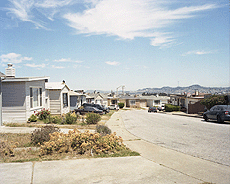Sarah Busse
Technologies of Windows
What I remember is dust from stacks of books,
dim light from small-paned windows--a dirty glimmer--
jammed or propped open (the prayer for air in summer),
and narrow hallways with odd twists and nooks.
More dust. More books, piled on shelves and floors
of small-ish offices, and smells: mildew
(if books had gotten wet) and binding glue
and smoke--this was when people smoked indoors.
Now no one smokes inside, books are Best Selling,
air centrally controlled. Ubiquitous
computers tell us what is going to happen.
Now we've let sunshine in from floor to ceiling
with our improved technologies of glass.
The view is stunning. The windows cannot open.
The Mothers
The mothers are searching for passion once again
amid the summer's broader amplitudes,
leaving our houses, striding down the lane
(these well-paved labyrinthine neighborhoods).
We walk alone. Sometimes we walk in pairs
and question passion, or wail the lack of one.
We end up where we started, go indoors
to drink our water, shower, check the phone.
Thank God there are no messages! For where
would any of us go, should passion call?
What would our husbands say? What would we wear?
Far better not to have to go at all.
The mothers walk in circles that repeat,
trusting the auspice of a local star.
We learn to manage risk and hedge each bet,
bypass desire, evade the minotaur. |
|
 |
 |
|
 |
Marion Belanger: My current project, Continental Drift: Iceland/California, is structured around the geologic boundary that forms the edge of the North Atlantic Continental Plate. I was particularly interested in the fact that this geological boundary has no political allegiance, was not determined by wars, by financial interest, or national demarcation. It is a boundary that cannot be controlled or contained by human intervention. | |
|
|
|
 |
|
 |
|
|
|
|
